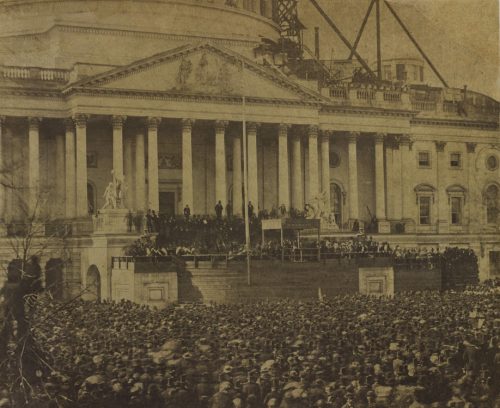Historic Lincoln Inauguration Photograph Unveiled
By Tom Porter
The week before President-elect Donald Trump’s inauguration, the Bowdoin College Museum of Art has formally unveiled a recently acquired photograph of President Abraham Lincoln’s first inauguration, almost 156 years after it was taken. This was among the earliest political ceremonies to be captured on film, and this photo is one of only three copies in existence, said museum co-director Frank Goodyear. “I got a little excited about this,” he said, describing the moment he learned the rare photo would be put up for auction at Sotheby’s in October. “This is, dare I say it, a national treasure of sorts.”
Slideshow of the event







The photograph was taken on March 4, 1861, by Alexander Gardner, and it shows a large crowd outside the east side of the US Capitol building, where a partially built dome is visible. President Lincoln’s inauguration ceremony is taking place beneath a wooden canopy. While it’s impossible to discern any individual figures in the photograph, Goodyear said it’s an exciting image because it represents a pioneering example of photojournalism. “Photography was only invented about twenty years earlier,” he told a crowd in the museum’s Zuckert seminar room, where the unveiling took place. Not a lot of pictures were taken outdoors in those days, he said, “because the equipment was cumbersome and the chemistry was so sensitive” that most photographers required a controlled studio setting. Another major reason the college acquired the photo, said Goodyear, is that it reveals an “extraordinary historical moment.”
The crowd at the museum was then addressed by Professor of History Patrick Rael, who has written extensively about the Civil War era. In November 1860, he explained, “Lincoln had captured the White House, leading a political party that stood against the expansion of slavery.” He then endured “the most challenging run-up to an inauguration that the United States had ever experienced,” he added. By the time the inauguration took place, several slave-owning states had left the union, led by South Carolina. Less than six weeks after Lincoln assumed the presidency, war broke out.
In his inaugural address, said Rael, Lincoln “insisted that the union was inviolable, and that his constitutional duty lay in maintaining it. And he placed the moral onus of belligerence on the seceding states. ‘In your hands, my dissatisfied fellow-countrymen, and not in mine, is the momentous issue of civil war,’ he told the South. ‘You can have no conflict without being yourselves the aggressors.’
Rael continued: “This photograph of the event captures a critical moment in our national history. At such points we define not just the rules, but the principles they uphold. The slice of time captured here marks the moment when the final contest over slavery became truly inevitable—the point at which a great hypocrisy at the founding of the nation could be righted.”